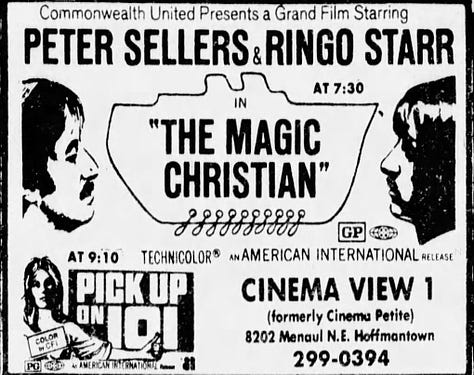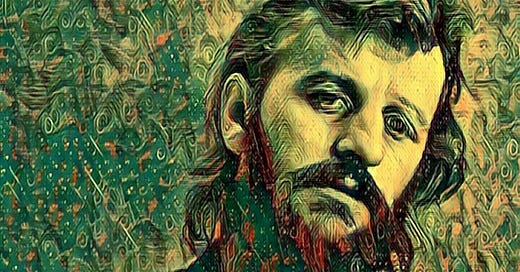There's something rather poetic about the way the threads of Beatles history continue to interweave, even as the principal players drift further apart. Take February 18, 1974 - a grey Monday in a Britain gripped by the three-day week, where the lights went out at 10:30 pm and the country seemed to be running on empty. Two seemingly unconnected events occurred that day involving the fab four - or should I say the not-so-fab-anymore four - that perfectly encapsulated the beautiful mess of the post-Beatles era.
In the glittering confines of Capitol Records' American HQ, Ringo's latest single "Oh My My" was being shipped to record stores across the United States, while across town in New York, John Lennon and his girlfriend May Pang made what must have been an achingly awkward visit to the Dakota building to wish Yoko Ono a happy birthday. If you'd told me back in '64, as I watched the band perform "I Want to Hold Your Hand" on Thank Your Lucky Stars, that this is where we'd end up, I'd have laughed you out of the room.
Ringo's American Dream
Let's start with our Richard. The release of "Oh My My" marked Ringo's sixth solo single since the Beatles' breakup, and bloody hell, wasn't he doing well for himself? The track, co-written with Vini Poncia, was a bouncing slice of good-time rock and roll that perfectly captured Starr's perpetually upbeat persona. It had been pulled from his 1973 album "Ringo" - an LP that had achieved something none of us thought possible: it had made Ringo the most commercially successful ex-Beatle of the moment.
The "Ringo" album had been a star-studded affair, featuring all three of his former bandmates (though never in the same room, mind you - let's not get carried away), along with Marc Bolan, Billy Preston, and members of The Band. The album had spawned two massive hits - "Photograph" (co-written with George Harrison) and "You're Sixteen" - both reaching number one in America. Not bad for the lad who once told me, during an interview in '65, that he was "just happy to be along for the ride."
The success hadn't come overnight, mind you. Ringo's early solo efforts had been a mixed bag - "Sentimental Journey", his collection of pre-rock standards, had left many scratching their heads, while "Beaucoups of Blues", his Nashville-recorded country album, had shown promise but failed to set the charts alight. It wasn't until he embraced his rock and roll roots with "Back Off Boogaloo" (produced by George Harrison) that things started looking up.
The Lost Weekend Continues
Meanwhile, in the bitter February cold of New York City, John Lennon was living what he'd later call his "Lost Weekend" - though at 18 months, it was a bloody long weekend by anyone's standards. He'd separated from Yoko Ono in the summer of '73, and at her suggestion, had taken up with their young assistant, May Pang. Yes, you read that right - Yoko had actually orchestrated the whole thing, proving once again that truth is stranger than any fiction I could possibly concoct.
May Pang wasn't just some bird John had picked up at the local boozer. She'd been working for John and Yoko since 1970, handling their business affairs and day-to-day life with remarkable efficiency. When Yoko decided that John needed time away (or that she needed time away from John, depending on who you believe), she suggested that May accompany him to Los Angeles. What started as a business arrangement turned into a romance that would last until early 1975.
The Los Angeles period had been particularly chaotic, even by Lennon's standards. He'd produced Harry Nilsson's "Pussy Cats" album, a process that nearly destroyed both men's voices, and had been thrown out of the Troubadour Club for heckling the Smothers Brothers while wearing a Kotex on his head. Yet amid the mayhem, he'd managed to record "Whatever Gets You Thru the Night" with Elton John, though it wouldn't be released until later in '74.
The Birthday Visit
The visit to the Dakota that February day was brief but loaded with significance. Yoko was turning 41, and despite their separation, John felt compelled to make an appearance. May Pang later wrote that they arrived bearing gifts and good wishes, but the atmosphere was thick enough to cut with a knife. Here was John, the working-class hero turned avant-garde artist, standing in the gothic splendour of the Dakota with his young girlfriend, facing the woman who had transformed his life and art so completely.
The Dakota itself was a far cry from the Hamburg clubs where I'd first seen the Beatles play. Built in 1884, it looked more like a German castle than a New York apartment building. Yoko had chosen it partly for its security features - the thick walls, the courtyard, the doorman - but also for its character. The building had already appeared in "Rosemary's Baby", and its gothic architecture seemed to reflect Yoko's artistic sensibilities.
Meanwhile, Back in Britain...
While all this was going on, Paul McCartney was holed up in his Scottish farm with Wings, putting the finishing touches to "Band on the Run" - an album that would soon restore his commercial fortunes after the relative disappointment of "Red Rose Speedway". The album had been recorded in Lagos, Nigeria, under trying circumstances - two band members had quit just before departure, and the McCartneys had been robbed at knifepoint, losing their demo tapes.
George Harrison was preparing for his first tour of North America as a solo artist, though the signs weren't good - his laryngitis was playing up something chronic, and the reviews of his new album "Living in the Material World" had been mixed at best. The tour would prove to be a difficult experience, with audiences expecting to hear Beatles songs while Harrison wanted to focus on his newer, more spiritually-oriented material.
The Music Scene
The Britain of February 1974 was a far cry from the swinging sixties that had nurtured the Beatles. Edward Heath's Conservative government was locked in a death struggle with the miners' union, and the country was operating on a three-day working week to conserve electricity. The charts that week were topped by Mud's "Tiger Feet", with Suzi Quatro's "Devil Gate Drive" hot on its heels. The New Seekers were warbling "You Won't Find Another Fool Like Me", which seemed an oddly appropriate soundtrack for the times.
The glam rock scene was in full swing, with Sweet's "Teenage Rampage" and Slade's "Every Night" fighting it out in the top ten. David Bowie had recently "retired" Ziggy Stardust and was exploring his "Diamond Dogs" persona. Meanwhile, prog rock was reaching its baroque peak - Yes had just released "Tales from Topographic Oceans", a double album featuring exactly four songs, one per side. Even by prog standards, that was pushing it.
Radio Days
On the radio, Tony Blackburn was still ruling the Radio 1 breakfast show, though Kenny Everett was providing stiff competition over at Capital Radio. The BBC was still adjusting to the arrival of commercial radio - Capital had launched in London the previous October, and other cities were preparing to follow suit. Radio Luxembourg continued to beam pop music across Europe in the evenings, though its signal was as unreliable as ever, fading in and out like a drunk trying to walk a straight line.
The previous Saturday, BBC1 had broadcast the Miss TV Times contest, while on ITV, viewers had been treated to another episode of "New Faces", where a young Victoria Wood had just won her heat. The nation was also gripped by "Whatever Happened to the Likely Lads?", while "Monkey" was introducing British viewers to Japanese television for the first time.
The Cultural Landscape
Cinema-wise, "The Exorcist" was causing controversy and queues around the block, while "Don't Look Now" was giving viewers the creeps in a more subtle way. The James Bond franchise had just introduced Roger Moore in "Live and Let Die", and "Jesus Christ Superstar" was bringing rock opera to the masses.
In the world of literature, Richard Adams' "Watership Down" was still riding high in the bestseller lists, while Martin Amis had just published his first novel, "The Rachel Papers". The theatre scene was dominated by Tom Stoppard's "Travesties" at the Aldwych, while the Royal Court was shocking audiences with Howard Brenton's "The Churchill Play".
Looking back, it's fascinating how February 18, 1974, captured so many of the recurring themes of the post-Beatles era: Ringo's surprising commercial success, John's personal turbulence, Paul's retreat to nature, and George's spiritual journey. The fact that these four lads from Liverpool could still command such attention and scrutiny nearly four years after their split speaks volumes about their enduring impact on popular culture.
The music scene they'd helped create was fragmenting into ever more specific genres - glam, prog, heavy metal, folk rock - yet none of these new forms could quite capture the universal appeal that the Beatles had achieved. The band's influence could still be heard everywhere, from the theatrical rock of Queen to the power pop of Badfinger, but their particular magic seemed increasingly unrepeatable.
As I sit here in my local, nursing a warm pint and scribbling these notes, I can't help but wonder what the teenage girls who'd screamed themselves hoarse at the Cavern Club would make of it all. Their beloved Beatles were now scattered to the four winds, making music that ranged from the sublime to the ridiculous, living lives that seemed increasingly removed from those heady days of Beatlemania.



But then again, maybe that was the point. The sixties were over, the dream was dead, and reality had set in with a vengeance. Yet somehow, improbably, magnificently, they were all still making music that mattered - even if they were making it apart. The events of February 18, 1974, were just another chapter in a story that showed no signs of ending, even as the principal characters drifted further from their shared past.





